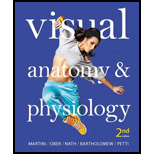
Visual Anatomy & Physiology (2nd Edition)
2nd Edition
ISBN: 9780321918949
Author: Frederic H. Martini, William C. Ober, Judi L. Nath, Edwin F. Bartholomew, Kevin F. Petti
Publisher: PEARSON
expand_more
expand_more
format_list_bulleted
Concept explainers
Question
Chapter 17, Problem 1CI
Summary Introduction
To identify: A hormone.
Introduction: Erythropoietin is a hormone primarily formed in the kidneys. It contributes a helps in red blood cell (RBC) production by inducing the bone marrow. RBCs carry oxygen from the lungs throughout the body.
Expert Solution & Answer
Want to see the full answer?
Check out a sample textbook solution
Students have asked these similar questions
What is the label ?
Can you described the image? Can you explain the question as well their answer and how to get to an answer to an problem like this?
glg 112 mid unit assignment Identifying melting processes
Chapter 17 Solutions
Visual Anatomy & Physiology (2nd Edition)
Ch. 17.1 - Prob. 1.1RCh. 17.1 - Prob. 1.2RCh. 17.1 - Prob. 1.3RCh. 17.1 - Prob. 2.1RCh. 17.1 - Prob. 2.2RCh. 17.1 - Prob. 2.3RCh. 17.1 - Prob. 3.1RCh. 17.1 - Prob. 3.2RCh. 17.1 - Prob. 3.3RCh. 17.1 - Prob. 1LO
Ch. 17.1 - Describe the important components and major...Ch. 17.1 - Prob. 3LOCh. 17.1 - Prob. 1SRCh. 17.1 - Prob. 2SRCh. 17.1 - Prob. 3SRCh. 17.1 - Prob. 4SRCh. 17.1 - Prob. 5SRCh. 17.1 - Prob. 6SRCh. 17.1 - Prob. 7SRCh. 17.1 - Prob. 8SRCh. 17.1 - Prob. 9SRCh. 17.1 - Prob. 10SRCh. 17.1 - Prob. 11SRCh. 17.1 - Prob. 12SRCh. 17.1 - Prob. 13SRCh. 17.1 - Prob. 14SRCh. 17.1 - Prob. 15SRCh. 17.2 - Prob. 1.1RCh. 17.2 - Prob. 1.2RCh. 17.2 - Prob. 1.3RCh. 17.2 - Prob. 2.1RCh. 17.2 - Prob. 2.2RCh. 17.2 - Prob. 2.3RCh. 17.2 - Prob. 3.1RCh. 17.2 - Prob. 3.2RCh. 17.2 - Prob. 3.3RCh. 17.2 - Prob. 4.1RCh. 17.2 - Prob. 4.2RCh. 17.2 - Prob. 4.3RCh. 17.2 - Prob. 5.1RCh. 17.2 - Prob. 5.2RCh. 17.2 - Prob. 5.3RCh. 17.2 - Prob. 6.1RCh. 17.2 - Prob. 6.2RCh. 17.2 - Prob. 6.3RCh. 17.2 - Prob. 7.1RCh. 17.2 - Prob. 7.2RCh. 17.2 - Prob. 7.3RCh. 17.2 - Prob. 8.1RCh. 17.2 - Prob. 8.2RCh. 17.2 - Prob. 8.3RCh. 17.2 - Prob. 1LOCh. 17.2 - Prob. 2LOCh. 17.2 - Prob. 3LOCh. 17.2 - Prob. 4LOCh. 17.2 - Prob. 5LOCh. 17.2 - Prob. 6LOCh. 17.2 - Prob. 7LOCh. 17.2 - Prob. 8LOCh. 17.2 - Prob. 1SRCh. 17.2 - Prob. 18SRCh. 17.2 - Prob. 19SRCh. 17.2 - Prob. 20SRCh. 17.2 - Prob. 21SRCh. 17.2 - Prob. 22SRCh. 17.2 - Prob. 23SRCh. 17.2 - Prob. 24SRCh. 17.2 - Prob. 25SRCh. 17.2 - Prob. 26SRCh. 17.2 - Prob. 27SRCh. 17.2 - Prob. 28SRCh. 17.2 - Prob. 29SRCh. 17.2 - Prob. 30SRCh. 17 - Prob. 1CRQCh. 17 - Prob. 2CRQCh. 17 - Prob. 3CRQCh. 17 - Prob. 4CRQCh. 17 - Prob. 5CRQCh. 17 - Prob. 6CRQCh. 17 - Prob. 7CRQCh. 17 - Prob. 8CRQCh. 17 - Prob. 9CRQCh. 17 - Prob. 10CRQCh. 17 - Prob. 11CRQCh. 17 - Prob. 12CRQCh. 17 - Prob. 13CRQCh. 17 - Prob. 14CRQCh. 17 - Prob. 15CRQCh. 17 - Prob. 16CRQCh. 17 - Prob. 17CRQCh. 17 - Prob. 18CRQCh. 17 - Describe the various types of leukemias.
Ch. 17 - Prob. 20CRQCh. 17 - Prob. 21CRQCh. 17 - Prob. 1CICh. 17 - Prob. 2CICh. 17 - Prob. 3CICh. 17 - Prob. 4CICh. 17 - Prob. 5CICh. 17 - Prob. 6CICh. 17 - Prob. 7CI
Knowledge Booster
Learn more about
Need a deep-dive on the concept behind this application? Look no further. Learn more about this topic, biology and related others by exploring similar questions and additional content below.Similar questions
- Explain how the hormones of the glands listed below travel around the body to target organs and tissues : Pituitary gland Hypothalamus Thyroid Parathyroid Adrenal Pineal Pancreas(islets of langerhans) Gonads (testes and ovaries) Placentaarrow_forwardWhat are the functions of the hormones produced in the glands listed below: Pituitary gland Hypothalamus Thyroid Parathyroid Adrenal Pineal Pancreas(islets of langerhans) Gonads (testes and ovaries) Placentaarrow_forwardDescribe the hormones produced in the glands listed below: Pituitary gland Hypothalamus Thyroid Parathyroid Adrenal Pineal Pancreas(islets of langerhans) Gonads (testes and ovaries) Placentaarrow_forward
- Please help me calculate drug dosage from the following information: Patient weight: 35 pounds, so 15.9 kilograms (got this by dividing 35 pounds by 2.2 kilograms) Drug dose: 0.05mg/kg Drug concentration: 2mg/mLarrow_forwardA 25-year-old woman presents to the emergency department with a 2-day history of fever, chills, severe headache, and confusion. She recently returned from a trip to sub-Saharan Africa, where she did not take malaria prophylaxis. On examination, she is febrile (39.8°C/103.6°F) and hypotensive. Laboratory studies reveal hemoglobin of 8.0 g/dL, platelet count of 50,000/μL, and evidence of hemoglobinuria. A peripheral blood smear shows ring forms and banana-shaped gametocytes. Which of the following Plasmodium species is most likely responsible for her severe symptoms? A. Plasmodium vivax B. Plasmodium ovale C. Plasmodium malariae D. Plasmodium falciparumarrow_forwardStandard Concentration (caffeine) mg/L Absorbance Reading 10 0.322 20 0.697 40 1.535 60 2.520 80 3.100arrow_forward
arrow_back_ios
SEE MORE QUESTIONS
arrow_forward_ios
Recommended textbooks for you
 Comprehensive Medical Assisting: Administrative a...NursingISBN:9781305964792Author:Wilburta Q. Lindh, Carol D. Tamparo, Barbara M. Dahl, Julie Morris, Cindy CorreaPublisher:Cengage Learning
Comprehensive Medical Assisting: Administrative a...NursingISBN:9781305964792Author:Wilburta Q. Lindh, Carol D. Tamparo, Barbara M. Dahl, Julie Morris, Cindy CorreaPublisher:Cengage Learning Human Physiology: From Cells to Systems (MindTap ...BiologyISBN:9781285866932Author:Lauralee SherwoodPublisher:Cengage Learning
Human Physiology: From Cells to Systems (MindTap ...BiologyISBN:9781285866932Author:Lauralee SherwoodPublisher:Cengage Learning Human Biology (MindTap Course List)BiologyISBN:9781305112100Author:Cecie Starr, Beverly McMillanPublisher:Cengage Learning
Human Biology (MindTap Course List)BiologyISBN:9781305112100Author:Cecie Starr, Beverly McMillanPublisher:Cengage Learning



Comprehensive Medical Assisting: Administrative a...
Nursing
ISBN:9781305964792
Author:Wilburta Q. Lindh, Carol D. Tamparo, Barbara M. Dahl, Julie Morris, Cindy Correa
Publisher:Cengage Learning

Human Physiology: From Cells to Systems (MindTap ...
Biology
ISBN:9781285866932
Author:Lauralee Sherwood
Publisher:Cengage Learning


Human Biology (MindTap Course List)
Biology
ISBN:9781305112100
Author:Cecie Starr, Beverly McMillan
Publisher:Cengage Learning